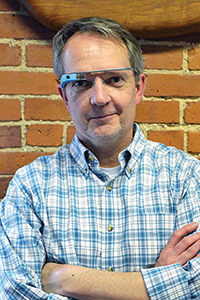Ad agency finds many uses for Google Glass
I have seen the future. Fortunately, I was not driving at the time, or I might have had a wreck.

This invention, as you probably have heard, puts many of the capabilities of a smartphone in devices that resemble eyeglass frames. Glass features a tiny screen over the right eye and can do amazing things: take a picture, record a video, perform a Google search, find directions or send a dictated message.
The position and size of the screen are designed to provide you with information without being distracting. Avoiding distraction, however, could take some practice. One writer reviewing the device found it difficult not to fixate on the screen. That could make walking, much less driving, a hazardous task.
In my brief trial, I was surprised not only by the range of capabilities the device offers but also the fact you can perform tasks with voice commands. I had seen news clips of people tapping or rubbing the frames to get things done, but I did not know you could summon its powers just by saying, “OK, Glass, take a picture.” Click, there you have a photo of whatever you’re seeing at the moment.
While I am convinced that Glass is an intriguing device, the question remains: Is this a toy or a tool?
Fell is exploring that question with his employees, who work in offices in Roanoke; Tampa, Fla.; Chattanooga, Tenn.; and Raleigh/Durham, N.C., in addition to Richmond. (The device has not yet gone on the market, but he obtained one through the Glass Explorer program, which allows some consumers to test the product and offer their feedback.)
Fell launched a companywide competition asking employees to submit ideas on ways to use Glass to help clients in various industries.
“Obviously, we are not endorsing the product or Google in any way,” he explains in an email. “Our interest is on staying ahead of the tech curve and giving our employees and our clients an opportunity to experience new devices and technologies as they come out.”
Fell thinks Glass technology is amazing, “but like any new technology like this you have to see (no pun intended) beyond the current iteration and understand the underlying advances and trends that will change our lives in the future — in this case, it’s about wearable technology, augmented reality, user-interface design, etc.”
One intriguing example of how Glass can be used is seen in a YouTube video. It follows Rocky Mount, N.C., firefighter Patrick Jackson on a training exercises in which he uses Glass to locate the nearest fire hydrant, obtain the floor plan of a burning building and find the right way to remove the roof of a wrecked car to free a trapped motorist.
Fell’s employees offered other ideas. Here are some of their responses. (These aren’t necessarily the winning entries, but they give you an idea of the wide-ranging suggestions the contest prompted.)
The collector
“Collectors of anything (antiques, coins, records, books, etc.) can quickly and easily access their personal catalog to avoid repurchasing same/similar items. Also: price check on aisle 3!”
The ghost tour
Provide Glass to guests for a “ghost” tour of a hotel to explain its history. “The app uses GPS to guide the guest through the hotel to specific spots. At each spot the wearer will be instructed to look at an image on the wall that will trigger a Glass video. In each video a person dressed in period garb will be the tour guide. They will appear as holograms and share info and stories pertaining to the historic facts they are sharing.” Guests can also take pictures and video along the tour for upload to social media sites.
The bike race
During the UCI World Road Cycling Championships scheduled to take place in Richmond next year, a rider would be asked to wear Glass. Using an app, spectators would view what the racer is seeing in real time during the competition.
The device also could be used to gather information on each rider, such as nationality, team affiliation and career record.
The memory care unit
“Glass could be incorporated into Alzheimer’s and dementia care. Glass would help stimulate the minds of patients by giving them games and puzzles to play.
“The ability to document daily life could help patients remember events that may seem cloudy.”
So will Glass be a personal technology game changer like the iPhone? Only time will tell. Remember that before Segways finally were unveiled 13 years ago, the hype was so intense that some people expected the machines to make a bigger splash than the personal computer.
My advice is to try out Glass if you get a chance but stay off the road until you’re used to it.
T
















